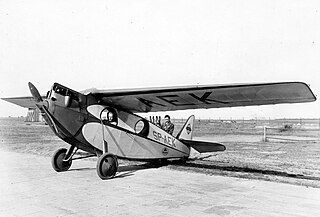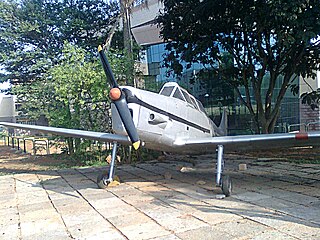
The RWD 5 was a Polish touring and sports plane of 1931, a two-seat high-wing monoplane, constructed by the RWD team. It was made famous by its transatlantic flight, being the smallest aircraft to cross the Atlantic.

The RWD 4 was a Polish sports plane of 1930, constructed by the RWD team.

The Miles M.28 Mercury was a British aircraft designed to meet the need for a training and communications plane during the Second World War. It was a single-engined monoplane of wooden construction with a twin tail and a tailwheel undercarriage with retractable main units.

The Avro Club Cadet was a 1930s single-engined British biplane trainer aircraft, designed and built by Avro as a development of the earlier Cadet. It was planned for private and club use and, unlike the Cadet, was fitted with folding wings.

The Comte AC-1 was a 1920s Swiss single-seat monoplane fighter aircraft produced by Flugzeugbau A. Comte.

The Bücker Bü 180 Student was a 1930s German two-seat sporting/training aircraft built by Bücker Flugzeugbau.

The Comte AC-3 was a bomber and transport aircraft designed and produced by the Swiss aircraft manufacturer Flugzeugbau A. Comte.
The Comte AC-8 was a 1930s Swiss six-seat light transport aircraft produced by Flugzeugbau A. Comte.

The Fairchild 22 Model C7 was an American two-seat touring or training monoplane designed and built by the Kreider-Reisner division of the Fairchild Aircraft Corporation at Hagerstown, Maryland.

The HAL HT-2 is an Indian two-seat primary trainer designed and built by Hindustan Aeronautics Limited (HAL). The HT-2 was the first company design to enter production in 1953 for the Indian Air Force and Navy, where it replaced the de Havilland Tiger Moth. The HT-2 is a low-wing cantilever monoplane with a fixed tailwheel landing gear. Powered by a 155 hp (116 kW) Cirrus Major III piston engine, the aircraft has enclosed tandem cockpits with dual controls. Apart from military use, the aircraft was also used by Indian flying schools.

The Westland Widgeon was a British light aircraft of the 1920s. A single-engined parasol monoplane, the Widgeon was built in small numbers before Westland abandoned production in 1929.

The Valentin Taifun is a two-seat self-launching sailplane designed and built by Valentin Flugzeugbau GmbH of Hasfurt, Germany.
The Deekay Knight was a British two-seat cabin monoplane designed by S.C.Hart-Still and built in 1937 by the Deekay Aircraft Corporation at Broxbourne in Hertfordshire, England. It was built to test methods of wing construction that would later be suitable for plastic skinning.

The Caudron C.510 Pélican was a 1930s French air ambulance or touring monoplane. Designed and built by Caudron and based on the earlier Caudron C.282/8.
The Caudron C.480 Frégate was a French three-seat touring monoplane designed by Maurice Devlieger and built by Société des avions Caudron.
The Bréguet 790 Nautilus was a prototype French three-seat coastal patrol flying-boat designed and built by Bréguet Aviation to meet a requirement from the French navy.

The Comte AC-12 Moskito was a 1930s Swiss three-seat light touring cabin monoplane produced by Flugzeugbau A. Comte.
The Comte AC-11-V was a 1930s Swiss three-seat cabin monoplane produced by Flugzeugbau A. Comte for aerial photography and mapping. The AC-11-V was a high-wing monoplane with a taikskid-conventional landing gear and powered by a 220 hp (164 kW) Armstrong Siddeley Lynx radial engine.

The Raab-Katzenstein RK.25 was a two-seat, low wing cantilever monoplane aircraft designed and built in Germany in the 1920s for fast touring. Three were built and one had some success in a 1928 international contest. Another was later re-engined and provided with cabin accommodation.
The Grob G 110 was a single-engined two-seat light aircraft, made mainly of glassfibre, that was designed and built by the German manufacturer Grob Aircraft in the early 1980s. Two prototypes were built, with the first example making its maiden flight on 6 February 1982, but development was abandoned after the first prototype crashed later that year.














